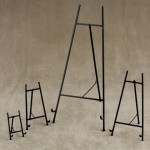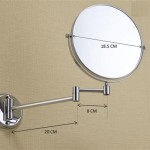What Paint To Use On Metal Mirror Frame
The selection of the appropriate paint for a metal mirror frame is crucial for achieving a visually appealing and durable finish. Metal surfaces, due to their inherent properties, require paints that can effectively adhere, resist corrosion, and withstand environmental factors. Understanding the characteristics of different paint types and their suitability for metal applications is essential for a successful painting project.
Several factors influence the choice of paint, including the type of metal the frame is made of, the desired aesthetic (e.g., gloss level, color), the intended environment of the mirror (e.g., humidity levels), and the level of surface preparation feasible. Proper surface preparation is paramount, as it directly impacts the paint's adhesion and longevity. Without adequate preparation, even the highest quality paint will likely fail, resulting in peeling, chipping, or rust formation.
This article will delve into the various types of paints suitable for metal mirror frames, discuss essential preparation steps, and offer insights into application techniques to ensure a professional and lasting result.
Understanding Common Metal Types and Their Paint Requirements
Metal mirror frames can be constructed from various materials, each possessing unique properties that affect paint adhesion and performance. Common metals include steel (including galvanized steel), aluminum, brass, and wrought iron. Identifying the specific metal composition of the frame is the first step in selecting the right paint.
Steel: Steel is a common and relatively inexpensive material. However, it is susceptible to rust. Therefore, paints designed to prevent corrosion are essential. Rust-inhibiting primers are particularly important when painting steel frames. For bare steel, a rust-converting primer is usually required.
Galvanized Steel: Galvanized steel is steel that has been coated with zinc to protect it from corrosion. This zinc coating provides excellent rust resistance, but it also presents a challenge for paint adhesion. Standard paints may not adhere well to galvanized surfaces, leading to peeling over time. Special primers formulated for galvanized metal are necessary to ensure proper adhesion. These primers often contain etching agents that create a rough surface for the paint to grip onto.
Aluminum: Aluminum is known for its lightweight and corrosion-resistant properties. It naturally forms a protective oxide layer that prevents rust. While aluminum is resistant to rust, it can still corrode under certain conditions, such as exposure to chlorides. As with galvanized steel, aluminum can be difficult to paint directly due to its smooth surface. Self-etching primers are recommended to provide a suitable base for subsequent paint coats.
Brass: Brass is an alloy of copper and zinc, known for its decorative appearance. Brass is generally resistant to corrosion, but it can tarnish over time, losing its luster. Paints for brass are often chosen for aesthetic reasons, such as changing the color or adding a protective layer to prevent tarnishing. Like aluminum and galvanized steel, brass benefits from a primer designed for non-ferrous metals to ensure good adhesion.
Wrought Iron: Wrought iron is a strong and durable material often used for decorative metalwork. It's less susceptible to rust than steel, but still requires protection, especially in outdoor environments. Rust-inhibiting primers and paints are essential for wrought iron frames to maintain their appearance and structural integrity. Due to its often intricate designs, proper application techniques, such as using brushes with the right shape and size, are crucial.
Exploring Suitable Paint Types for Metal Mirror Frames
The market offers a wide range of paint types that can be used on metal. Each type possesses distinct characteristics that make it suitable for different applications. Here's a breakdown of some of the most common and effective options for metal mirror frames:
Oil-Based Paints: Oil-based paints are known for their durability, excellent adhesion, and smooth finish. They provide a hard, protective coating that is resistant to scratches and wear. However, they have a longer drying time compared to other types and require mineral spirits or paint thinner for cleanup. Oil-based paints are suitable for both interior and exterior applications, but they are becoming less common due to the availability of more environmentally friendly alternatives.
Latex (Water-Based) Paints: Latex paints are popular due to their ease of use, low odor, and quick drying time. They are also more environmentally friendly than oil-based paints. While latex paints have improved significantly in recent years, they may not be as durable or resistant to abrasion as oil-based paints. However, high-quality acrylic latex paints can offer excellent performance on metal surfaces, especially when used with a suitable primer. They are generally preferred for interior applications.
Acrylic Paints: Acrylic paints are a type of latex paint that offers superior adhesion, durability, and color retention. They are water-based and easy to clean up. Acrylic paints are more flexible than oil-based paints, making them less prone to cracking or chipping. They are a good choice for metal mirror frames that may be subject to temperature fluctuations or movement. Acrylic paints are versatile and can be used for both interior and exterior applications.
Epoxy Paints: Epoxy paints are two-part systems that consist of a resin and a hardener. When mixed, they create a very hard, durable, and chemical-resistant coating. Epoxy paints are excellent for high-traffic areas or environments where the mirror frame will be exposed to harsh chemicals or solvents. They offer superior corrosion protection and are often used in industrial applications. However, epoxy paints can be more difficult to apply and require proper ventilation due to the strong fumes.
Enamel Paints: Enamel paints are known for their hard, glossy finish and excellent durability. They are available in both oil-based and water-based formulations. Enamel paints are resistant to scratches, stains, and fading, making them a good choice for metal mirror frames that will be frequently handled or exposed to sunlight. Alkyd enamel paints (oil-based) provide a particularly tough and durable finish. However, they also have longer drying times and require solvent-based cleanup.
Spray Paints: Spray paints are a convenient option for painting metal mirror frames, especially those with intricate designs. They provide a smooth, even coat and are easy to apply. Spray paints are available in a wide range of colors and finishes, including enamel, acrylic, and lacquer. When using spray paint, it is essential to apply multiple thin coats rather than one thick coat to avoid runs and drips. Proper ventilation and respiratory protection are also necessary.
Rust-Oleum: Rust-Oleum is a brand that specializes in rust-preventative coatings. Their paints are specifically formulated to protect metal from corrosion and are available in a variety of formulations, including oil-based and latex. Rust-Oleum paints are a good choice for metal mirror frames that are exposed to moisture or other corrosive elements. They often contain rust-inhibiting pigments that help to prevent the formation of rust and extend the lifespan of the frame.
Essential Surface Preparation Techniques
Proper surface preparation is critical for ensuring that the paint adheres well to the metal and provides long-lasting protection. The steps involved in surface preparation will vary depending on the condition of the metal and the type of paint being used. However, the following are some general guidelines:
Cleaning: Begin by cleaning the metal surface thoroughly to remove any dirt, grease, oil, rust, or loose paint. Use a degreaser or a strong detergent solution to remove grease and oil. Rinse the surface with clean water and allow it to dry completely. For stubborn stains or rust, use a wire brush or sandpaper to scrub the surface.
Sanding: Sanding the metal surface helps to create a rough texture that the paint can grip onto. Use medium-grit sandpaper (e.g., 120-grit) to sand the entire surface, paying particular attention to areas with rust or imperfections. After sanding, remove any dust with a clean cloth or tack cloth. For very smooth metal surfaces, consider using a coarser grit sandpaper (e.g., 80-grit) to create a more aggressive profile for the paint to adhere to.
Rust Removal: If the metal frame has rust, it is essential to remove it completely before painting. Small areas of rust can be removed with a wire brush or sandpaper. For more extensive rust, use a rust remover or a chemical treatment to dissolve the rust. Follow the manufacturer's instructions carefully when using chemical rust removers. After removing the rust, be sure to neutralize the surface with a rust converter or primer before painting.
Priming: Priming is essential for ensuring proper paint adhesion and corrosion protection. Use a primer specifically designed for metal surfaces. Self-etching primers are particularly effective for aluminum, galvanized steel, and other non-ferrous metals. Apply the primer in thin, even coats, following the manufacturer's instructions. Allow the primer to dry completely before applying the topcoat. The choice of primer is just as important as the topcoat. Select a primer that is compatible with the type of paint being used for the topcoat.
Masking: Before painting, mask off any areas that you do not want to be painted, such as the mirror itself or any decorative elements. Use painter's tape to create clean, sharp lines. Be sure to press the tape firmly against the surface to prevent paint from bleeding underneath. If necessary, use plastic sheeting or paper to protect surrounding areas from overspray.
By following these surface preparation techniques, it is possible to create a clean, smooth, and properly prepared surface that will ensure the paint adheres well, provides long-lasting protection, and enhances the overall appearance of the metal mirror frame.

Metal Mirror Makeover Simple Method Artsy Rule

How To Paint A Mirror Frame Gold Easily In Two Steps

Painted Mirror Using Paint Glaze To Enhance Details Sand And Sisal

How To Paint A Mirror Frame The Easy Way By Just Woods

How To Paint Gold Mirror Frame Keeping The Ornate Features Vickymyerscreations

Mirror Painting Ideas Easy Diy On A Budget Debt Free Forties

Metal Mirror Makeover Simple Method Artsy Rule

How To Paint A Mirror Frame The Easy Way By Just Woods

Diy Painted Mirror Frames

Painting A Metal Mirror Frame To Look Like Wood Exquisitely Unremarkable








